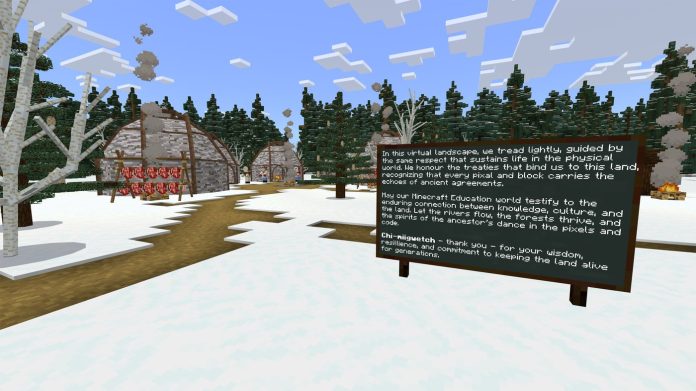
Maggie Macintosh
Local Journalism Initiative Reporter
Winnipeg Free Press
A Manitoba First Nation is the muse for a new educational video game wherein students ride sled dogs and hunt moose as a study of land stewardship and the Anishinaabe way of life.
Bloodvein First Nation and Logics Academy, a coding and learning experience design company, have developed a special edition of Minecraft Education in the likeness of traditional land on the east side of Lake Winnipeg.
“This is part of sharing what we have with the general public so that they’ll understand how closely connected we are to the land, and why we protect it,” said William Young, an elder who runs land-based programs in Bloodvein.
A character modelled after Young is among the first to greet users as they set out on a journey through a series of winter activities.
One mission tasks players with an ice-fishing adventure on the frozen Bloodvein River. They learn how to cut holes, identify local fish species — pickerel, jackfish and sturgeon — and scope out hidden pictographs along the riverbank.
The block-building and adventure game is targeted at students in grades 6 to 8.
It takes place in a pixelated version of Pimachiowin Aki (“the land that gives life”), Canada’s first dual world heritage site.
What makes 2.9-million hectare area special is that it’s intact and the work to protect its boreal forests, marshlands and waterways has been community-driven, Young said.
He was instrumental in getting the United Nations to recognize Pimachiowin Aki — a swath that encompasses his home, as well as Little Grand Rapids, Pauingassi and Poplar River — as a cultural and environmental gem in 2018.
The designation honours the Anishinaabe worldview of a symbiotic relationship between humans and nature, and the landmarks, such as trap lines, that reflect the way residents and their ancestors have made use of the region for upwards of 7,000 years.
In exploring a virtual replica of it in the world’s best-selling video game, which came online this month, students learn about biodiversity and traditional land management.
“We’re using it as an incentive to get kids excited about learning about land-based activities and learning about the area in general,” said Jim Moar, information technology specialist at Miskooseepi School, the kindergarten-to-Grade 10 school in Bloodvein, which is about 235 kilometres north of Winnipeg.
Moar said teachers will leverage the tool’s “escapism” appeal and hopefully, it will spark interest in participating in real-life activities on the land.
The plan is to keep updating the map with new missions and tap students to help design elements, he added.
It cost $57,000 to launch the initial version. The school forked out some of its operating dollars, but the bulk of it was paid for with a voucher connected to a class action settlement involving Microsoft, owner of Minecraft.
The Manitoba First Nations School System deployed an education technology facilitator to support the video game’s development throughout 2023-24.
Karl Hildebrandt said the project aims to raise the profile of Pimachiowin Aki and instill pride in students about where they come from.
“How cool is it to play a video game based on your community?” he quipped.
Bloodvein youth, many of whom have relatives featured in the virtual universe, had the chance to test out early renderings.
Videos of elders from their community have been uploaded to bolster game-based learning, along with lesson plan ideas.
Mike Washburn, director of learning experiences at Logics Academy, said Manitoba has become a world leader in creating Indigenous-themed content in Minecraft.
The latest project is unique because of its massive scale and focus on land-based education, the former classroom teacher said, adding he pitches the program as a teaching tool because children are drawn to its immersiveness, customizable elements and multi-player nature.
He noted that teachers and anyone else with a Microsoft 365 licence has access to the game.
“Now the world is going to get a chance to experience (Bloodvein),” Washburn said. “There’s going to be kids from Korea and Thailand and Brazil learning about a little Indigenous community in northern Manitoba.”
maggie.macintosh@freepress.mb.ca

